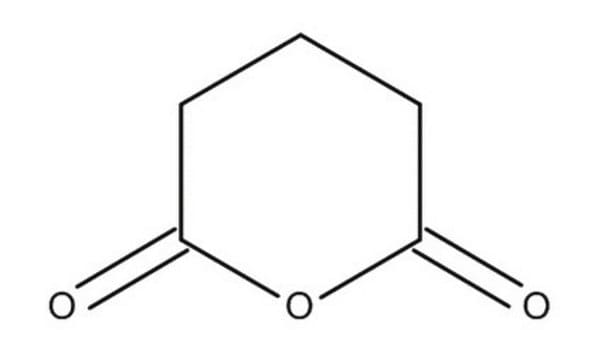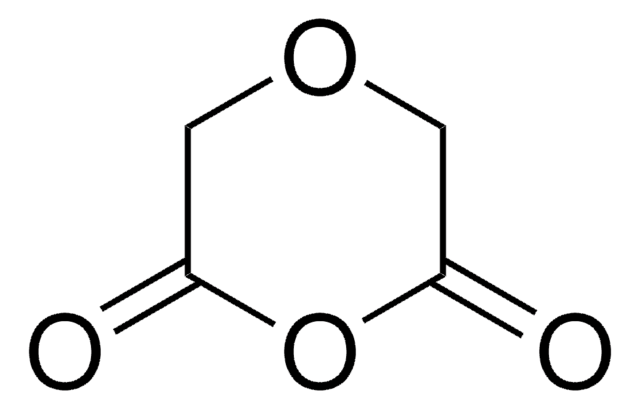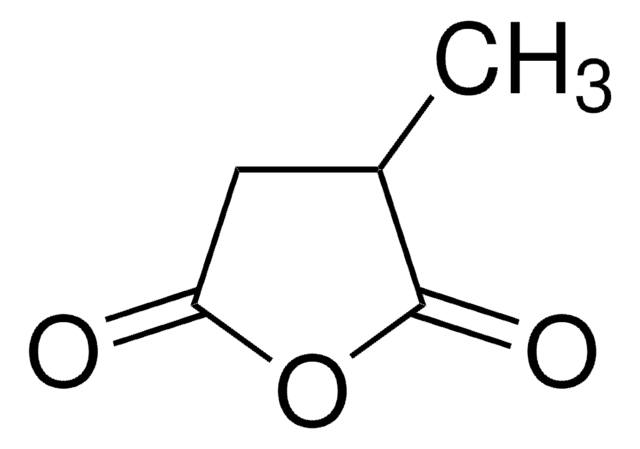G3806
Glutaric anhydride
95%
Synonim(y):
Pentanedioic anhydride
About This Item
Polecane produkty
Próba
95%
tw
150 °C/10 mmHg (lit.)
mp
50-55 °C (lit.)
ciąg SMILES
O=C1CCCC(=O)O1
InChI
1S/C5H6O3/c6-4-2-1-3-5(7)8-4/h1-3H2
Klucz InChI
VANNPISTIUFMLH-UHFFFAOYSA-N
Szukasz podobnych produktów? Odwiedź Przewodnik dotyczący porównywania produktów
Powiązane kategorie
Zastosowanie
- Esterification mechanism of bagasse modified with glutaric anhydride in 1-allyl-3-methylimidazolium chloride: This study explores the homogenous esterification of bagasse with glutaric anhydride, providing insight into the effects of glutaric anhydride dosage on the process (H Wang et al., 2017).
- Epoxy-anhydride vitrimers from aminoglycidyl resins with high glass transition temperature and efficient stress relaxation: Discusses the use of glutaric anhydride as a hardener in high-performance epoxy-based composites, comparing its effectiveness with other hardeners (M Giebler et al., 2020).
- Effects of glutaric anhydride functionalization on filler-free benzoxazine/epoxy copolymers with shape memory and self-healing properties under near-infrared light: Examines how glutaric anhydride enhances the properties of copolymers, particularly in terms of shape memory and self-healing capabilities (L Amornkitbamrung et al., 2022).
- Surface analysis and thermal behavior of the functionalized cellulose by glutaric anhydride through a solvent-free and catalyst-free process: Investigates the modification of cellulose using glutaric anhydride and analyzes its impact on thermal behavior and surface properties (H Fahim et al., 2023).
- Cyclic anhydrides as powerful tools for bioconjugation and smart delivery: This article reviews the use of glutaric anhydride in bioconjugation, highlighting its potential in creating smart delivery systems for biologically active compounds (MV Spanedda et al., 2021).
Hasło ostrzegawcze
Danger
Zwroty wskazujące rodzaj zagrożenia
Zwroty wskazujące środki ostrożności
Klasyfikacja zagrożeń
Acute Tox. 4 Oral - Eye Dam. 1 - Skin Irrit. 2
Kod klasy składowania
11 - Combustible Solids
Klasa zagrożenia wodnego (WGK)
WGK 1
Temperatura zapłonu (°F)
347.0 °F - closed cup
Temperatura zapłonu (°C)
175 °C - closed cup
Środki ochrony indywidualnej
dust mask type N95 (US), Eyeshields, Gloves
Certyfikaty analizy (CoA)
Poszukaj Certyfikaty analizy (CoA), wpisując numer partii/serii produktów. Numery serii i partii można znaleźć na etykiecie produktu po słowach „seria” lub „partia”.
Masz już ten produkt?
Dokumenty związane z niedawno zakupionymi produktami zostały zamieszczone w Bibliotece dokumentów.
Nasz zespół naukowców ma doświadczenie we wszystkich obszarach badań, w tym w naukach przyrodniczych, materiałoznawstwie, syntezie chemicznej, chromatografii, analityce i wielu innych dziedzinach.
Skontaktuj się z zespołem ds. pomocy technicznej










